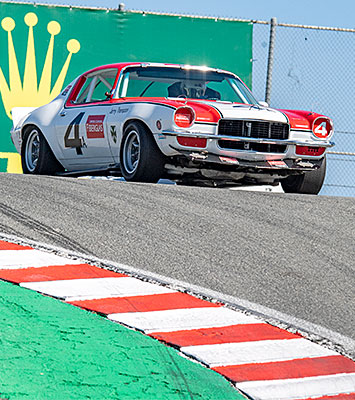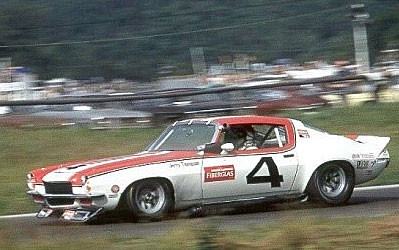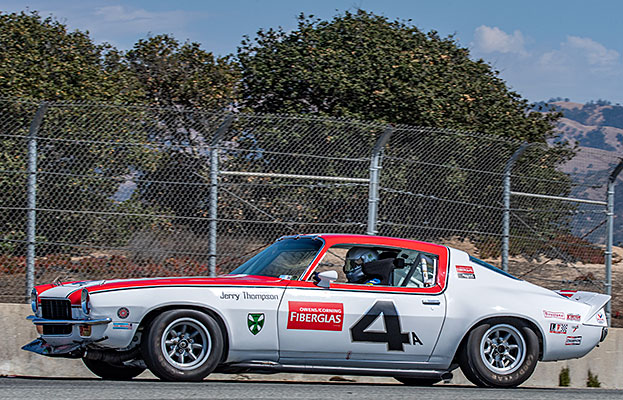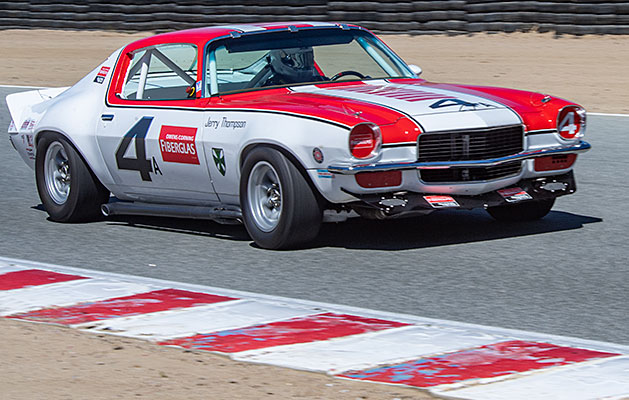

Mike Joy - Lewisville, North Carolina
1970 Chevrolet Camaro Z28 #4
Originally driven by Tony DeLorenzo and Jerry Thompson








Number 3 is Tony Lorenzo and Number 4 is Jerry Thompson.
Documented History:
This car was prepared for the 1970 Trans AM season by the very successful amateur Owens Corning Fiberglas Corvette racing team.
A die stamping of the new curvy quarters had been problematic, causing production of the new body style to be delayed until the first of the year when the Body-in-White new Camaro chassis was delivered to Tony DeLorenzo and team in late January.
|
 Tony Lorenzo's first time out, at Lime Rock. Tony Lorenzo's first time out, at Lime Rock. |
 Jerry Thompson at Road Atlanta. Jerry Thompson at Road Atlanta. |
 |
The bodies were then delivered to Logghe Stamping for the roll cage construction. Logghe brothers were famous Fuel Dragster chassis builders and they also built the cages for the Jim Hall Chaparral Camaros. The cage was built of 1.5” .090 tubing and the forward cage struts had mounting plates that bolted to the subframe per the rules at the time. Most competitors subsequently welded these to the subframe in later years when allowed. This car's roll cagae is still bolted in place as the period would require!
With just the body shells being provided, much parts scrounging took place at Chevrolet. When Jerry Thompson was asked how the cars ended up with Saddle Tan padded dashboards, he responded with "we were just frantic for parts and could not be particular!”
|

Bob Eienerth in the 1972 Watkins Glen TransAm race.
|
 |

Jerry Thompson at Riverside. |
 |
Logghe made new rear inner fenders (tubs) of .125 steel for strength and weight bias to the rear. The sub-frame was double welded, suspension mounts gusseted, upper A-arm repositioned, and Delrin bushings adapted. The lower A-arms received mono-balls instead of bushings as did the forward eye of the rear leaf springs and each end of the double adjustable Koni shock absorbers. The rear leaf spring was off-set inboard for tire clearance and the GM-supplied “Patch Panel” fender flairs were welded to the body.
|
 |
 |
Limited edition spindles were eventually acquired from GM, specially made to mount J56 Corvette brakes directly to the race spindles and a larger axle bearing Impala 12 bolt posi-traction differential was used at the rear. A Harrison Oil cooler was installed along with an L88 aluminum radiator. Bill King's Machine Shop assembled the 302 engines not far from the OCF shop. A NASCAR style Cowl Air Induction system was adapted to the Camaro engine compartment.
To represent one of the Corvette sponsors, OK Kustom headers and sidepipes were adapted, becoming a signature feature. Power steering and brakes were used, as on the Chaparral Camaros, which was unusual at the time. A tilt steering wheel, GM Transistor ignition, 20 Gal ATL fuel cell, fiberglass racing seat, and 8” wide magnesium Minilite wheels completed the preparation.
|
 |

Jerry Thompson at Road America. |
GM designer Randy Wittine mimicked the color scheme used on the OCF Corvettes and created the most striking graphics of the Trans Am race cars at that time. The paint job alone made the car a favorite of many race fans.
|
 |
 |
| Jerry Thompson at Riverside in 1970. |
Jerry Thompson in the 1970 St. Jovite TransAm. |
|
1970 Race History
| Date |
Place |
Start |
Finish |
# |
Laps |
Money |
| May 9 |
Lime Rock |
21 |
DNF |
3 |
|
|
| May 31 |
Bryar Motorsports Park |
15 |
7 |
4 |
83 |
1,200 |
| Jun 7 |
Mid-Ohio Sports Car Course |
11 |
29 |
4 |
0 |
|
| Jul 19 |
Road America |
34 |
21 |
4 |
43 |
50 |
| Aug 2 |
Circuit Mont-Tremblant |
15 |
7 |
4 |
68 |
1,200 |
| Aug 16 |
Watkins Glen International |
12 |
27 DNF |
4 |
54 |
50 |
| Sep 20 |
Pacific Raceways |
16 |
25 DNF |
4 |
34 |
50 |
| Oct 4 |
Riverside International Raceway |
17 |
33 DNF |
4 |
14 |
|
|
 |
 |
|
1972 Race History with Bob Boenerth
|
|
|
|
|
| Date |
Race |
Grid |
Finish |
| 6-May |
Lime Rock |
28 |
14 |
| 29-May |
Bryar |
20 |
13 |
| 4-Jun |
Mid Ohio |
34 |
13 |
| 17-Jun |
Watkins Glen |
27 |
18 |
| 16-Jul |
Road America |
34 |
17 |
| 30-Jul |
Sanair |
27 |
7 |
|





 Tony Lorenzo's first time out, at Lime Rock.
Tony Lorenzo's first time out, at Lime Rock. Jerry Thompson at Road Atlanta.
Jerry Thompson at Road Atlanta.



















